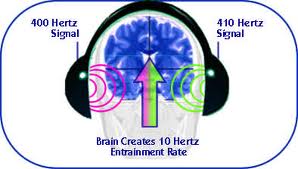
Binaural Audio Brain Training
Someone suggested in a recent post about meditation that I look into the effects of Binaural Beats. I had researched the subject several years ago and had good results but the technology for generating the audio was still in its proprietary phase and so the (free) tools that I was using required C compilers and building your own waveforms in text files. Today, there are binaural sound production application all over the mobile market as well as for home usage.
 For those unfamiliar with binaural audio (or binaural beats), the basic premise is that playing two different frequencies, one in the left ear and the other in the right, results in a perceived third frequency. Scientific research has shown that the aural effects are measurable and actually do create these audio frequency hallucinations as well as physical responses to the hallucinated sound as if the listener was actually “hearing” the sound. Further research has shown that brainwave patterns will begin to move closer to the frequency of continual sound. This process is called entrainment and it is this process that has lead to the study and use of binaural beats to change brainwave patterns to reach a desired mental state. The table below lists observed brainwave frequencies and what they are associated with when observing them:
For those unfamiliar with binaural audio (or binaural beats), the basic premise is that playing two different frequencies, one in the left ear and the other in the right, results in a perceived third frequency. Scientific research has shown that the aural effects are measurable and actually do create these audio frequency hallucinations as well as physical responses to the hallucinated sound as if the listener was actually “hearing” the sound. Further research has shown that brainwave patterns will begin to move closer to the frequency of continual sound. This process is called entrainment and it is this process that has lead to the study and use of binaural beats to change brainwave patterns to reach a desired mental state. The table below lists observed brainwave frequencies and what they are associated with when observing them:
| Frequency range | Name | Usually associated with: |
|---|---|---|
| > 40 Hz | Gamma waves | Higher mental activity, including perception, problem solving, fear, and consciousness |
| 13-39 Hz | Beta waves | Active, busy or anxious thinking and active concentration, arousal, cognition, and or paranoia |
| 7-13 Hz | Alpha waves | Relaxation (while awake), pre-sleep and pre-wake drowsiness, REM sleep, Dreams |
| 4-7 Hz | Theta waves | deep meditation/relaxation, NREM sleep |
| < 4 Hz | Delta waves | Deep dreamless sleep, loss of body awareness |
Binaural beat stimulation has been used fairly extensively to induce a variety of states of consciousness, and there has been some work done in regards to the effects of these stimuli on relaxation, focus, attention, and states of consciousness. Studies have shown that with repeated training to distinguish close frequency sounds that a plastic reorganization of the brain occurs for the trained frequencies. So, in theory, those that have trouble quieting the mind or sitting still long enough to focus for meditation could use this method to train the mind to be able to enter into these brainwave states.